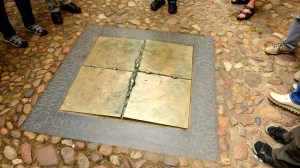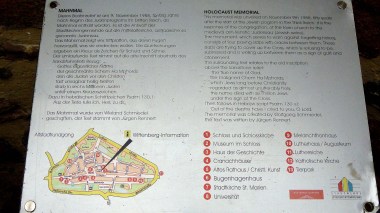The highly anticipated 500th anniversary of the Protestant Reformation is coming up in 2017 and the epicenter of the Reformation, Wittenberg, Germany, has been preparing for years. Visitors from around the world are already trickling in to visit historical sites such as the Castle Church where Martin Luther is purported to have posted his 95 Theses condemning the Catholic Church’s sale of indulgences.
However, St. Mary’s, or the Town Church, in Wittenberg, where Luther regularly preached, married his wife Katharina von Bora, and baptized their six children, is currently drawing greater attention because of a challenge to remove a 700-year-old anti-Semitic sculpture from its facade.
Perched 26 feet above the ground, on the exterior southeast corner of the Town Church, is a 14th-century sandstone sculpture of a pig with two people in identifiably medieval Jewish hats suckling at its teats and another holding a piglet’s ear. An additional Jewish person lifts the tail while looking into the sow’s rear. Written above the relief is an inscription with the words, “Rabini Shem Hamphoras.” This nonsensical reference to the Jewish appellation of God’s name, added after Luther’s time, quotes a derogatory comment in one of Luther’s writings.
This is not the only “Judensau” or “Jew pig” carving in Germany. As many as a couple hundred may have existed between the 13th and 18th centuries inside and outside of churches, as well as on homes, woodcuts, and broadsheets in German lands of the Holy Roman Empire. The Wittenberg sculpture has been cleaned up and restored as part of a 7.5-million-euro church restoration effort because of its 80,000 annual visitors and in anticipation of the 2017 festivities.
“The Judensau grieves people because our Lord is blasphemed,” said Lutheran Sister Joela Krüger, 74, who is at the forefront of a movement to remove the offensive artifact from the church. “And also the Jews and Israel are blasphemed by showing such a sculpture.”
Sister Joela belongs to the Evangelical Sisterhood of Mary, a Lutheran Christian group based in Darmstadt, Germany, which is not part of the official Evangelical Church in Germany, or EKD, which is akin to the mainline Protestant churches in the United States. With 116 sisters in Germany and 46 more throughout 11 nations, the Sisterhood’s main mission focuses on repentance, Christian reconciliation, and the education of Christians about the Jewish roots of their faith.
About 30 “Judensau” sculptures still exist on churches mostly throughout Germany, and the majority without explanatory plaques. Scholars do not know who first commissioned the pieces. According to Birgit Wiedl, a researcher at the Institute for Jewish History in Vienna, Austria, these sculptures could have been commissioned by rulers, bishops, or through private donors. The only known commissioner for a “Judensau” was the city council of Salzburg who set one up on its town hall in 1487. A bishop eventually removed it during the Enlightenment in the 18th century.
The meaning of the sculpture develops over time, according to the research of the late Israeli historian, Isaiah Shachar, who wrote a seminal book on the “Judensau.” What began as symbol of a particular vice such as gluttony, reluctance to repent, uncleanness, sinfulness, or heresy, later becomes a clearly defamatory representation of the Jewish people. While pigs are commonly portrayed in German religious sculptures, Jewish law views them as unclean animals, not appropriate for eating, and therefore the use of the pig deliberately escalates the offense of the image.
The interpretation of the imagery of the “Judensau” has contributed to the darker part of Luther’s legacy.
The interpretation of the imagery of the “Judensau” has contributed to the darker part of Luther’s legacy. In 1543 in his work, On the Schem Hamphoras, Luther insults the Talmud (rabbinic writings) and the Jewish name for God by linking them to the actions of the Jews on the sow sculpture. According to Thomas Kaufmann, chair of church history in the department of theology at the University of Göttingen, a professor of theology who lived in Wittenberg sometime after Luther’s death may have added the inscription above the sculpture.
In 2014, Sister Joela wrote a letter to more than 20 bishops in the EKD asking for the removal of the “Judensau” from the Town Church because of its vile imagery and its link to Martin Luther. The sister received a dozen responses from the Lutheran bishops who were sympathetic, but ultimately absolved themselves of the responsibility. Instead, they directed her to the parish church of Wittenberg as having the sole authority to determine the fate of the sculpture. With a sense of urgency to her mission, Sister Joela wrote to Pastor Johannes Block of the Town Church in June 2016, hoping to see the sculpture removed before the 500th anniversary of the Reformation in 2017.
Block told her that the defamatory sculpture had been under discussion during the 1980s when the church was part of communist East Germany and that the current parish council is committed to upholding a culture of remembrance by leaving it in place.

The German text of the monument is translated into English on an additional wall plaque as, “The true name of God, the maligned Chem Hamphoras, which Jews long before Christianity regarded as almost unutterably holy, this name died with six million Jews under the sign of the cross.” On the margins of the plaque in Hebrew are the words from Psalm 130, “Out of the depths, I cry to you.”Prior to German reunification, the Town Church leaders spoke with the Jewish community of the nearby city of Magdeburg, who supported the decision to keep the sculpture on the church. As a result of the discussions, the youth group within the church decided to create a memorial plaque, and on November 11, 1988, in honor of the 50th anniversary of Kristallnacht (when Nazis burned Jewish stores and synagogues), the Town Church installed a Holocaust memorial on the ground to counteract the “Judensau.” The vice-chairman of the synagogue community of Magdeburg in 1988, Dr. Gunther Helbig, gave a speech at the unveiling ceremony, according to the church’s website.
“I have seen the counter-monument on the ground draped with flowers, with wreaths, saying never again,” said Timothy Bennett, associate professor of languages at Wittenberg University in Ohio—the sister city of Wittenberg, Germany. Bennett has taken groups of students to Wittenberg about ten times since 1989. “I’ve seen stones placed on it. I’ve seen tourist groups come through and talk about it.”
The counter-monument’s role, as explained on the wall, is to not allow this history to be forgotten. The design of four blocks with cracks in between symbolizes a cross that wells up as a sign of guilt and atonement.
Sister Joela finds the memorial unclear and critically lacking in an explanation of its connection to Martin Luther. She feels there is a good culture of remembrance in Germany, but supports an approach that involves deeper acts of repentance. Sister Joela acknowledges Luther’s revolutionary role in democratizing the Bible, but also recognizes his failings with the Jewish people. “We don’t want to distance ourselves from Luther’s wrongs, but to identify, grieve, and ask for forgiveness,” she said.
Professor Kaufmann from Gottingen, who has recently published a book about Luther and the Jews, said that Luther writes negatively about the Jewish people in three of his books. The three anti-Jewish tracts make up only about 2 percent of Luther’s works, said Kaufmann, but the question of how to deal with the Jews and Luther’s reflections on Judaism is present in his entire corpus, on nearly every page, due to his interaction with the New Testament.
Luther approached the Jews in a derogatory way, said Kaufmann, because of they rejected Jesus as Messiah, despite “hints” about him throughout the Old Testament. Luther blamed the Talmud, or rabbinic writings, for improper interpretation of the Hebrew Bible.
“Luther’s theological position against Judaism in the beginning of his theological work is the same as in the end,” said Kaufmann. “What differs is the strategy to deal with the Jewish people.” In the early 1520’s, Luther blamed the lack of conversions on the Roman Catholic Church who kept the Jews from the true gospel. He initially believed that after they had exposure to the gospel, they would convert. But, after decades of failure to convert Jews, Luther held them responsible for their resistance to the gospel.
Despite these views, Kaufmann does not blame Luther for the extermination of the Jews during the Holocaust, even though Luther’s anti-Semitic exhortations were picked up by Nazi propaganda. “He wants to suppress the Jews,” said Kaufmann, “to make Jewish life impossible, to expel them from the place where Christians live.”
The Jewish communities … have concluded that it should remain in place as a blatant reminder of anti-Semitism.
Members of the Jewish community today in Germany number about 100,000, including 1400 in the state of Saxony-Anhalt, where Wittenberg is located. The Jewish communities in the area have recently discussed the removal of the “Judensau” and they have concluded that it should remain in place as a blatant reminder of anti-Semitism.
“We think that the sculpture represents a testimony of medieval thinking and Christian architectural tradition,” said Max Privorozki, chairman of the executive committee of the association of Jewish communities in the state of Saxony-Anhalt.
“There is no doubt that the 14th-century ‘Judensau’ sculpture at Wittenberg is unseemly, obscene, insulting, offensive, libelous, and a portrayal of hate speech and anti-Semitism and that it defames Jewish people and their faith,” said Privorozki. “However, it should be seen within the context of the time period in which it was made.”
Rabbi Zsolt Balla, a member of the Orthodox Rabbinic Conference of Germany, admits the “Judensau” is a complex matter. He thinks the memorial is the right approach; however, he would like to see Luther quoted on it in order to understand how historical figures were not flawless and that church elite participated in anti-Semitism.

Despite Luther’s sins, the Christian world, including the evangelicals in Germany, still consider him an important person and a reformer who changed the world. “Seeing him with his errors and scars and still being thankful for his life, writings, and teachings is vital to celebrating the 500th anniversary of the Reformation in the right way,” said Michael Diener, chairman of the German Evangelical Alliance.
The evangelical community in Germany seems to have mixed opinions on the issue of the removal of the “Judensau,” although they agree on rejecting anti-Semitism. The board of the Evangelical Alliance in Germany has not formally discussed the issue, said Diener, but he would prefer to leave this witness to medieval anti-Semitism (and its influence on the later pogroms) in its historic place as a reminder to the importance of opposing discrimination.
Even though many want the sculpture to remain, Sister Joela is not alone in her attempt to remove it. She sits on the US advisory board of a group called “Wittenberg 2017,” whose goal is reconciliation between different denominations, particularly through exploring the sins of history that brought about the divisions. This group wrote an article calling for the removal of the “Judensau” in the summer of 2016. One member, Richard Harvey, a Messianic Jew from England, has started a petition on change.org for the removal of the “Judensau.” To date, it has nearly reached its goal of 5,000 signatures.
“I fully respect the fact that such anti-Semitic offenses should never be forgotten and stand as a reminder to prevent them happening again,” said Harvey. “But to insist that they should remain on a place of worship goes against the message of the gospel itself.”
Most recently the charismatic renewal movement in Germany (GGE Deutschland) has joined Sister Joela’s cause. Pastor Henning Dobers, chairman of the movement, has signed Harvey’s petition and is encouraging all within the movement to support it. He doesn’t want to destroy the relief, but suggests gathering the remaining ones together and placing them in a museum with historical and theological explanations. This has already occurred with two “Judensau” in Wiener Neustadt and Bad Wimpfen, which have been placed in municipal museums.
“If the church is a vibrant place of worship, a ‘Judensau’ sculpture has no place within it.”
The notion of removing the sculptures from places of worship is also supported by Ansgar Hörsting, the president of the Evangelical Free Churches of Germany. “If the church is a vibrant place of worship, a ‘Judensau’ sculpture has no place within it,” he said. However, Hörsting stresses that if the church is more like a museum, then there is less of a problem with leaving it in place. The question is whether the Town Church of Wittenberg should be considered more of a historical tourist attraction or if it is still a house of worship. The Town Church has around 50 to 100 Sunday attendants.
The city of Wittenberg expects 1 million tourists during this year and 100,000 during the culminating ceremonies on October 31, 2017, according to city officials. The Town Church, also known as the mother church of the Reformation, is the oldest structure in Wittenberg and is a UNESCO World Heritage Site, which might pose additional challenges to the removal of the artifact.
A new pastor, Alexander Garth, is slated to replace the current pastor of the Town Church in the fall of 2016. He has already promised to erect another memorial with words of condemnation and repentance.
Sister Joela’s deepest desire would be to take the sculpture down and replace it with something that would honor the Jewish people. “The Lord urged me to try this last step,” she said, “focusing on the 500th anniversary of the Reformation. I feel it is the last moment in history to do something.”
Deborah Pardo-Kaplan is a freelance journalist living in Austin, Texas. She is currently working on her memoir, Solomon's Porch, about her life as a Messianic Jew.










